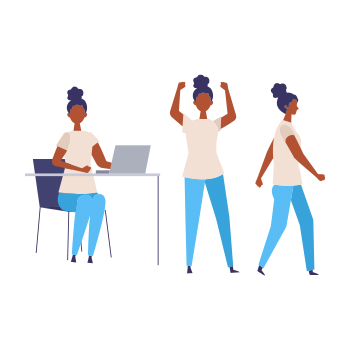


Sign-up for {N}power to get exclusive discounts, newsletters, members-only features, and more!
 Denver - Design District - Alameda and Broadway
Denver - Design District - Alameda and Broadway
368 S Broadway
Denver, CO 80209
United States
 Preferred Store:
Select a Store
Preferred Store:
Select a Store

It has been said that sitting is the new smoking. This is following research linking prolonged sitting to higher risks of health problems, including cardiovascular disease. While startling news, a 2022 systematic review and meta-analysis published in Sports Medicine1 found that interrupting prolonged sitting with light physical activity can help counter sitting’s negative effects and provide benefits to cardiovascular and metabolic health.
In the study, researchers analyzed seven randomized crossover trials that looked at the health effects of a single day of continued sitting (≥ 5hrs) versus interrupting sitting with short bouts of standing or light-intensity walking in adults. Specifically, they looked at the impacts of these interventions on various cardiometabolic health markers like blood sugar (glucose) and insulin levels in response to a meal.
 Compared to continuous sitting, adding frequent, short breaks of either standing or walking resulted in significant improvements in glucose levels following a meal, reducing average glucose by 9.5% (standing) or 17% (walking). Light intensity walking also significantly reduced post-meal insulin levels. The researchers pointed out that while standing and light-intensity walking were both beneficial, light-intensity walking proved to be a superior intervention since it led to the greatest improvements in cardiometabolic health markers. The frequency and duration of sitting breaks varied among the studies, but many prescribed two-minute breaks every twenty minutes or five-minute breaks every thirty minutes.
Compared to continuous sitting, adding frequent, short breaks of either standing or walking resulted in significant improvements in glucose levels following a meal, reducing average glucose by 9.5% (standing) or 17% (walking). Light intensity walking also significantly reduced post-meal insulin levels. The researchers pointed out that while standing and light-intensity walking were both beneficial, light-intensity walking proved to be a superior intervention since it led to the greatest improvements in cardiometabolic health markers. The frequency and duration of sitting breaks varied among the studies, but many prescribed two-minute breaks every twenty minutes or five-minute breaks every thirty minutes.
These findings are encouraging and further highlight that taking steps to decrease our sedentary time throughout the day can have significant positive impacts on our health.
It’s increasingly recognized that excessive time spent viewing and working on electronic devices like computers and smart phones stresses the eyes and can lead to declines in visual function. This includes losses in sharp or clear vision, known as visual acuity. However, a 2022 double-blind, placebo-controlled trial published in the Journal of Clinical Biochemistry and Nutrition2 suggests that daily astaxanthin supplementation may preserve visual acuity in the presence of continuous and chronic screen time.
 In the study, 60 healthy Japanese men and women aged 20-64 years who regularly performed computer work and experienced frequent eye fatigue were given 9 mg/day supplemental astaxanthin for six weeks. At the beginning and end of the study, visual acuity was assessed while the participants played a video game for one hour. Compared to placebo, six weeks of astaxanthin supplementation in those 40 years and older proved to be a successful intervention in preventing visual acuity loss from prolonged screen time. In particular, this age group experienced significantly less changes in near-vision visual acuity, meaning objects further away were less blurry.
In the study, 60 healthy Japanese men and women aged 20-64 years who regularly performed computer work and experienced frequent eye fatigue were given 9 mg/day supplemental astaxanthin for six weeks. At the beginning and end of the study, visual acuity was assessed while the participants played a video game for one hour. Compared to placebo, six weeks of astaxanthin supplementation in those 40 years and older proved to be a successful intervention in preventing visual acuity loss from prolonged screen time. In particular, this age group experienced significantly less changes in near-vision visual acuity, meaning objects further away were less blurry.
Astaxanthin is a carotenoid that is a well-known antioxidant. It can protect the eye from oxidative stress that can lead to eye damage and deterioration in visual function. Astaxanthin can also improve blood flow to the eye, which supports the optimal function of ocular muscles that help focus vision.



Sign-up for {N}power to get exclusive discounts, newsletters, members-only features, and more!
